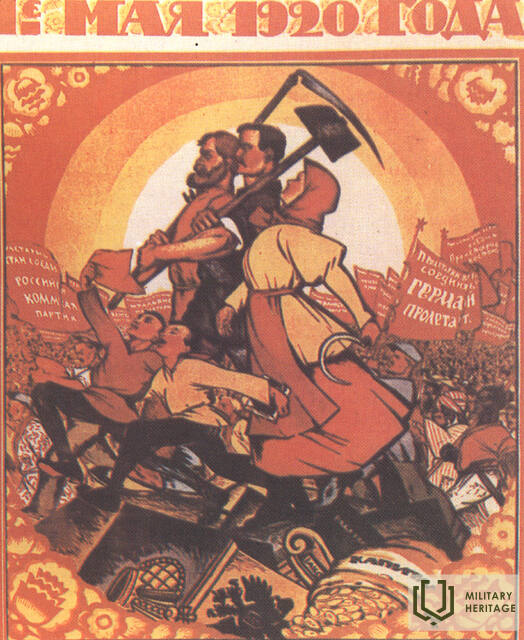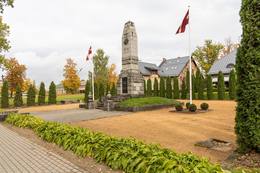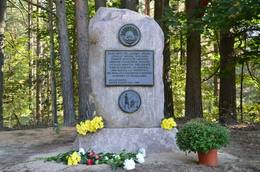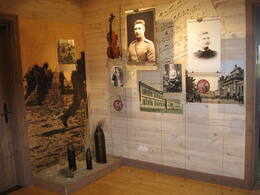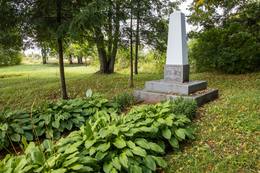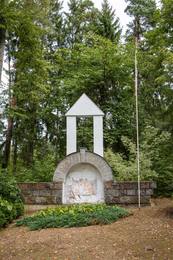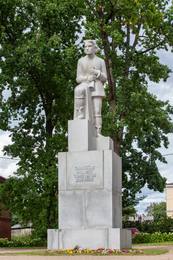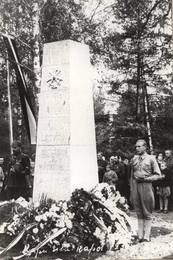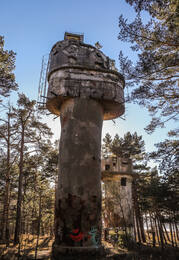Latvijos Tarybų Respublika, 1919-1920 m
I Nepriklausomybės karai
Latvijos Socialistinė Tarybų Respublika – sovietinis režimas Latvijoje. Sovietų Latvija iš dalies buvo suvereni iki 1919 06 01, po to ji faktiškai buvo Sovietų Rusijos dalis.
Susijusi laiko juosta
Susijusios vietos
Monument to the fallen heroes of Gulbene parish in Latvia
Located in the historical center of Gulbene, opposite the Gulbene Evangelical Lutheran Church.
Monument to the victims of the riots of 1905, members of the Gulbene congregation who fell in the First World War and the Latvian War of Independence, and the victims of the Maliena tribunal. The monument was designed by E. Ābeltiņš and was unveiled in 1929 in front of the Gulbene Evangelical Lutheran Church. After the Second World War, a five-pointed star was placed on the monument, then - on its foundations - a plaster image of a Soviet soldier was painted in bronze, and a cemetery of fallen Soviet soldiers was erected behind the monument. When the new cemeteries of Soviet soldiers who died in World War II were opened in Spārīte Park in 1969, the remains of the fallen were transported there, but the site of the monument was leveled with the ground. In the autumn of 1989, the foundations of the monument were excavated and the capsule with the text built into them in 1928 was excavated. The monument was restored in 1992 (sculptor O. Feldbergs).
Between December 24, 1918 and May 31, 1919, when the 1st (4th) Valmiera Infantry Regiment liberated Gulbene from the Bolsheviks, the Maliena (Vecgulbene) Revolutionary War Tribunal and Workers' Club were located in the church. It stood out for the severity of its decisions and the high number of death sentences, often for minor offenses, in which 349 cases were investigated and 606 people were charged.
A memorial sculpture can be seen.
A place of remembrance of the events of the Latvian War of Independence in Mārupe
It is located in the Mārupe region, on the side of the road between the Viesturi golf club and the Božu reservoir.
The memorial was opened in 2013. The history of the area is connected with the battle of the Latvian army against Bermont troops in 1919. Not far from Adainai's house, units of the Latvian army were stationed in combat positions.
During the War of Independence, due to the difficult situation, the Latvian government lacked the opportunity to supply the army with the necessary supplies. The appearance and armament of the soldiers varied. Most often, supply was based on the soldiers' ability to provide for themselves. At the end of September and beginning of October 1919, a Latvian military order came from Great Britain to eliminate the shortcomings. A month later, he also received a delivery of English armaments. With the first shipments, it was understood that Britain was getting rid of unnecessary stocks. Dirty, worn clothes and shoes, often too small, were also received. Soldiers wearing inappropriate footwear created health problems that affected combat capabilities. The garment was mended and re-stitched. The main unifying symbol was the 11-ray sun sign on the hat and a red-and-white armband around the left arm.
Today, several places of remembrance can be seen here. The facilities are part of a scenic, specially designed history and nature hiking route.
Guide Miķelis Yakunovs, +371 28353679.
Oskars Kalpaks Museum and Memorial Site “Airītes”
The Oskars Kalpaks Museum and Memorial Site Airītes is located between Saldus and Skrunda near the A9 highway. The exhibit has extensive information about Colonel Oskars Kalpaks and his battalion, and shows the history of the Latvian National Army and the memorial site Airītes. The exhibit reveals Colonel Oskars Kalpaks as a personality, as a soldier and as a fighter for Latvia's independence. Audio logs in Latvian, English and German are also available as part of the exhibit. They emphasize the importance of the historic events of 1918/1919 in the protecting the statehood of Latvia. The museum building has been restored.
Entry is free; guided tour – for a fee. The complex has a recreation area, a park, an obstacle course, it is possible to take various classes, and there is a seminar hall for up to 30 people.
Monument to the soldiers of the 1st Liepaja Infantry Regiment at the battlefield of 1919
Located in Madona district, Murmastiene parish, Meža Strodu village, 6 km from Varakļāni.
A monument to the Freedom Fights can be seen at the battlefield of the 1st Liepaja Infantry Regiment, where in 1919 they fought against the "red" army. Not far from this place, Aleksandrs Lakstīgala, a countryman, was seriously wounded in the battle. A dead man was found near his home. Therefore, the location of this monument was chosen.
On August 16, 1936, the granite Victory Monument (it was called in the press of that time) was unveiled to commemorate the Freedom Fights, engraved with the words: “1. every corner of our homeland - so now ours. ” It was installed by the leadership of the Rēzekne Guard Regiment, consecrated by the senior pastor of the Rēzekne Guard Regiment Vincents Tomašūnas with the local parish dean Kalinka. The opening debts were accepted by Žanis Bach, the commander of the Zemgale division and a knight of the Lāčplēsis Order. In 1950, it was demolished and destroyed. On November 16, 1996, the restored monument was inaugurated, also in honor of the 78th anniversary of the proclamation of the Republic of Latvia.
Paminklas „Talavos trimitininkas“
Located in Rūjiena Center Square.
The three-meter-high image of an ancient Latvian guardian carved in gray Finnish granite, called the “Tālava trumpeter”, is placed on a three-meter-high granite pedestal, but the total height of the monument reaches 7.5 meters. In the initial sketches and models, K. Zemdega had placed a sword in his hands, which was later replaced by a trumpet. The monument was unveiled on August 15, 1937.
This monument reflects the difficult situation in the formation of our country and army, as well as in the assessment of these events. Immediately after the proclamation of the Latvian state, the Red Army invaded and the interim government of Kārlis Ulmanis established a refuge in Liepāja. In February 1919, with the help of the Estonian army, the liberation of Latvia from the north began and the first mobilization took place in the Rūjiena area for the Latvian troops formed in Tartu, which became the Northern Latvian Brigade under the command of Colonel Jorgis Zemitans. The Northern Latvian brigade fought not only against the Bolsheviks, but also against the Landeswehr and Iron Division in the battles of Cēsis. The soldiers of Northern Latvia, mobilized in the vicinity of Rūjiena, also fought in the subsequent battles for the War of Independence. After the war, the main laurels were won by General Jānis Balodis and the Southern Latvian Brigade he commanded, but he often forgot about the Northern Latvian Brigade. The monument to Rūjiena, which was planned in Rūjiena, was built for a long time, and the monument, unveiled in 1937, was officially popularized as a monument to the liberation of Rūjiena and the memory of fallen soldiers, not to mention the beginning of all regiments in Northern Latvia.
The monument is not only a popular sight for Latvian and Estonian tourists, which is to some extent a starting point for visiting several other places of remembrance of the War of Independence in Rūjiena, but "Tālavas taurētājs" is also a stopping place for Estonian and Latvian officials of various levels.
The monument to the liberation and fallen soldiers of Rūjiena, more commonly known as the “trumpet of Tālava”, was included in the list of cultural monuments protected by the state as an art monument of national significance on October 29, 1998 (monument protection registration number 4522).
Karosta, the Military port of Liepāja (tour)
The Karosta is the largest historical military territory in the Baltics and occupies almost one third of the entire territory of Liepāja. The Karosta is a unique compound of military and fortification buildings on the shores of the Baltic Sea with a special meaning in the history and architecture of Latvia and the world. The Karosta features such military heritage sites as the North Pier and forts, the Redan, Karosta Prison, Karosta Water Tower, St. Nicholas Orthodox Maritime Cathedral, Oskars Kalpaks Bridge and others.
Susijusi istorija
Cėsių mūšis Amatos upės pakrantėje
Prie tilto per Amatą vokiečių Landesveras puola deryboms atvykusį Estijos šarvuotąjį traukinį. Estai atidaro priešugnį, vokiečiai atmušami, o šarvuotas traukinys grįžta į Cėsis.
Cėsių mūšio pradžia, eiga ir pabaiga
Pergalei Cėsių mūšyje buvo lemta tapti lūžiu latvių ir estų kovoje už savo šalies nepriklausomybę. Ši pergalė padarė tašką Andrievo Niedros vyriausybės ir vokiečių generolo Rüdigerio von der Goltzo planams užkariauti Baltijos šalis. Vietoj to Liepojoje savo veiklą atnaujino Laikinoji Latvijos vyriausybė, vadovaujama Kārlio Ulmanio.
Paskutinis pulkininko Kalpako mūšis prie Airytės
Pulkininkas Kalpaks buvo gerbiamas veikėjas kariniuose sluoksniuose ir tikras patriotas. Būtent patriotizmo dvasia ir nelemtas atsitiktinumas lėmė lemtingą jo ir vokiečių batalionų susidūrimą, kuris, deja, baigėsi pulkininko Kalpako žūtimi.
Estijos karinis jūrų laivynas padeda Latvijos pajėgoms Nepriklausomybės karo metu
Birželio 23 dieną estai švenčia Pergalės dieną, pažymėdami bendrą Latvijos ir Estijos pergalę Cėsių mūšyje. Ir šioje pergalėje nemažą vaidmenį suvaidino Estijos karinis jūrų laivynas, kuris šiame Landesvero kare, kaip jį vadina estai, savo drąsiais veiksmais ir tikslia patrankų ugnimi Dauguvos žiotyse kėlė grėsmę pagrindiniams vokiečių pajėgų tiekimo maršrutams per Dauguvą visai netoli Rygos.
Apie pirmąjį Latvijos kariuomenės vadą Dāvidą Sīmansoną
Knygoje „Latvijos kariuomenės vadai“ esantys rašiniai įtikina, kad istorijai didelę įtaką daro konkretūs asmenys. Nors svarbiausių istorinių įvykių epicentre jie buvo neilgai, tikri Latvijos patriotai, turėdami turtingą karinę patirtį, sugebėjo daug nuveikti formuojant ir stiprinant Latvijos kariuomenę bei istorinių įvykių lūžio momentuose.
Ši istorija pasakoja apie pirmąjį Latvijos kariuomenės vadą Dāvidą Sīmansoną (1859-1933).
Kyšulys ir laivas "Saratov"
Galima daryti prielaidą, kad Liepoja trumpą laiką buvo Latvijos sostinė, nes Laisvės kovų metu Laikinoji vyriausybė stovėjo laive Saratov būtent šiame mieste. Laikinąją vyriausybę po išvadavimo Saratovas nugabeno į Rygą, tačiau daug kas nežino, kad tokio mums svarbaus laivo istorija baigėsi jūroje ties Akmenrage.




